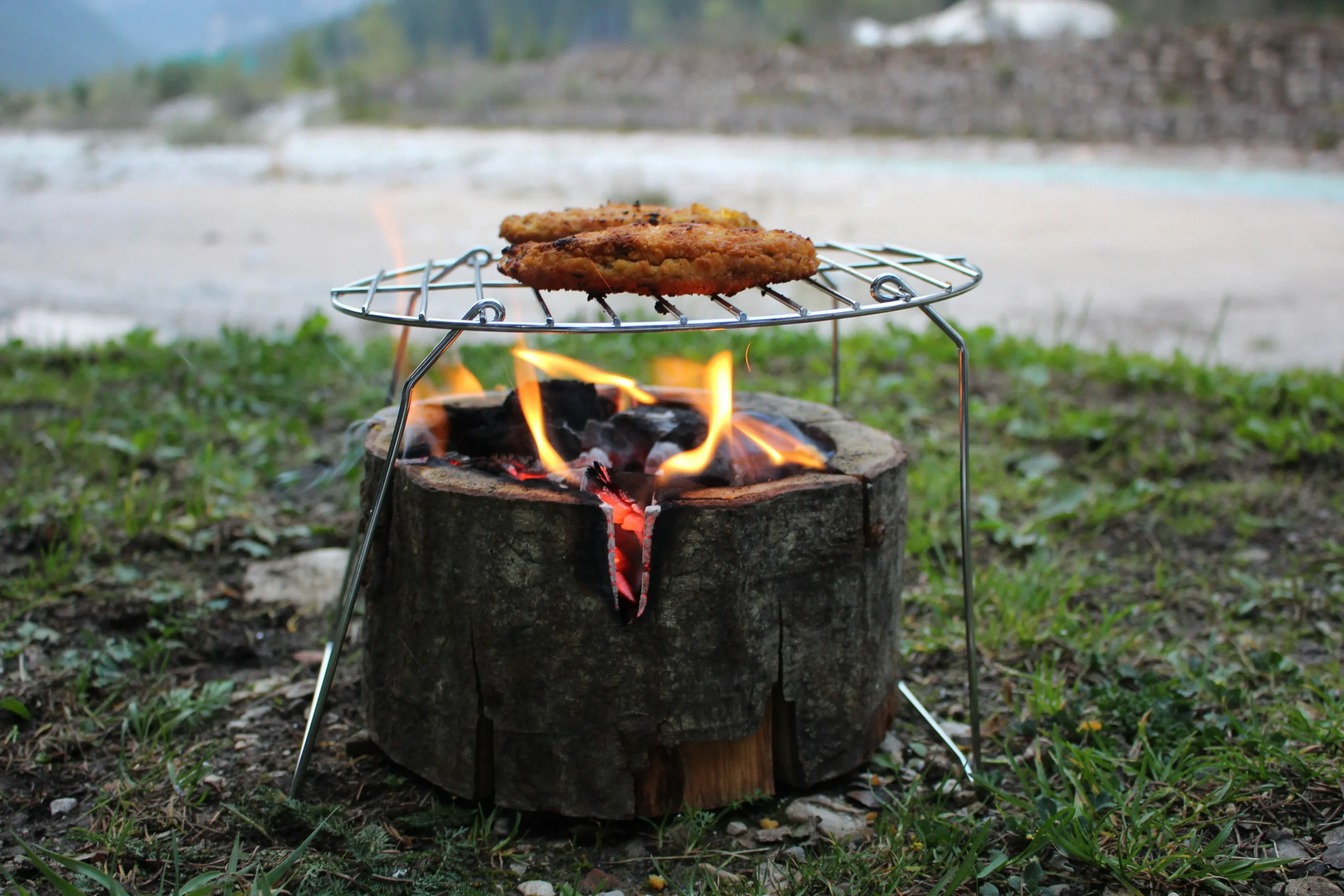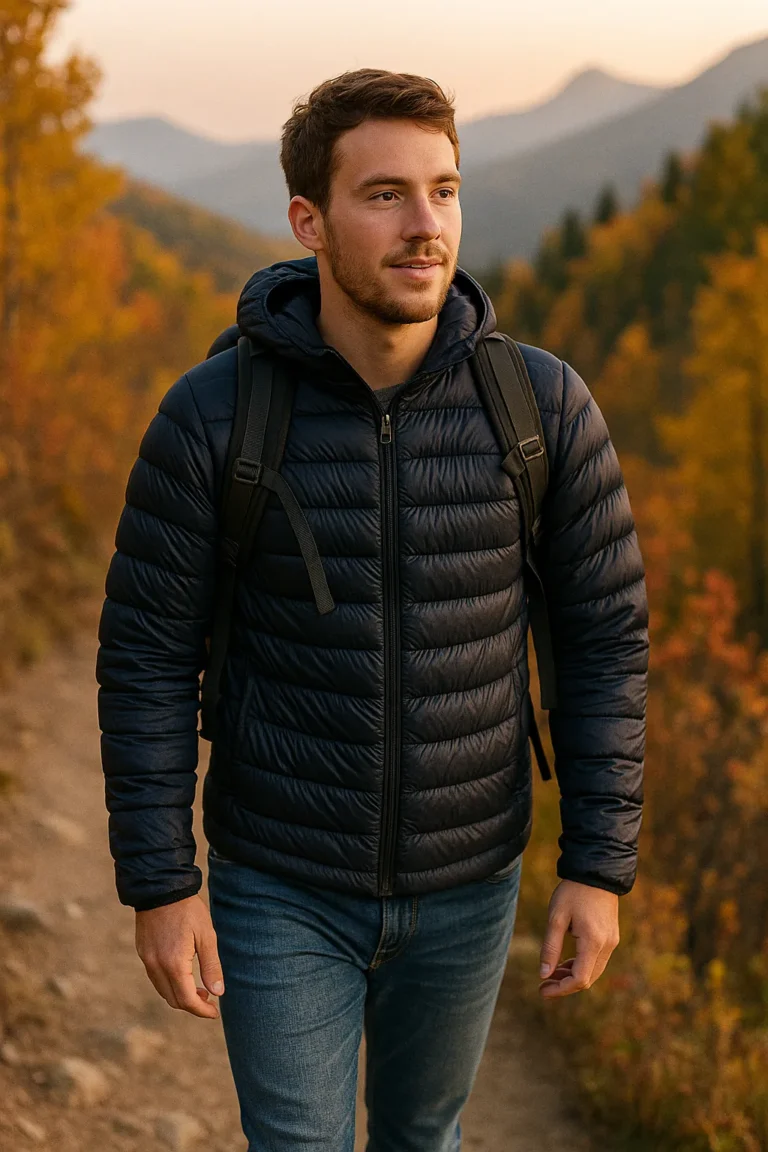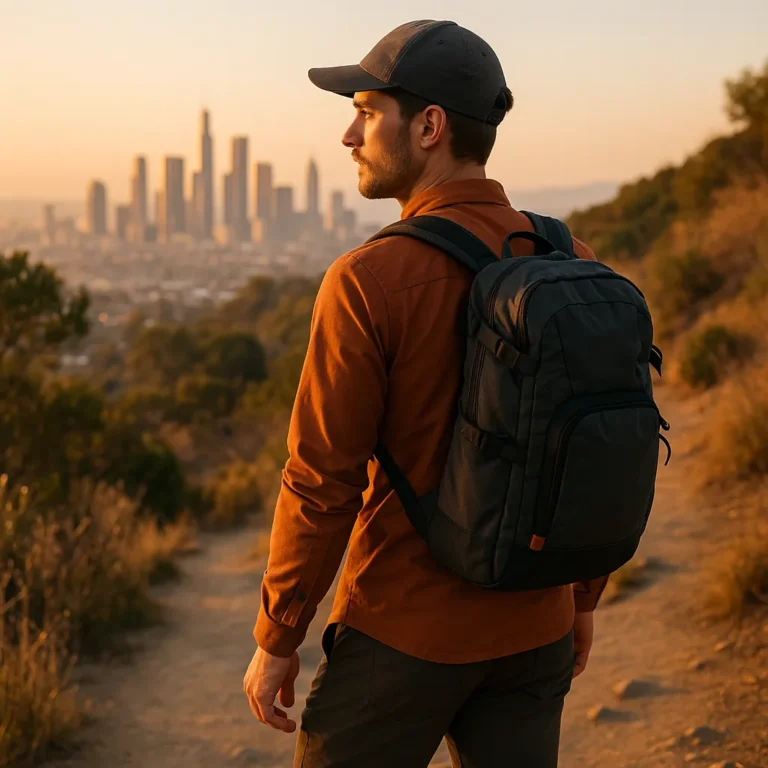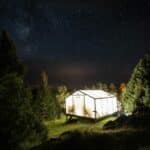Category: Gear | Type: Product Review & Buying Guide | Focus: Portable Campfire Grills | Time: 9 m
Last updated: April 2025
Introduction
Cooking over an open flame is a timeless part of camping — but doing it right takes more than just balancing a pot on some rocks. That’s where a portable campfire grill comes in: lightweight, packable, and built to handle the heat.
Unlike bulky backyard setups or delicate backpacking stoves, these foldable campfire grates are designed to sit directly over a campfire or hot coals, giving you a reliable platform for pots, pans, or straight-up grilling. Whether you’re searing steaks, roasting vegetables, or just boiling water for your morning coffee, a good campfire cooking grate brings versatility to your camp cooking equipment without weighing you down.
After analyzing dozens of models and examining hundreds of user experiences, I’ve highlighted the best portable campfire grills of 2025, based on real-world durability, heat handling, packability, and ease of use. If you’re looking to enhance your outdoor cooking gear for your next adventure, this guide will help you find the perfect grill for your specific needs.
Related: Looking for more ways to optimize your camp kitchen? Check out our guide to Top 7 Camping Tools Under 100g That Serious Backpackers Swear By which includes ultralight cooking solutions.
Comparing the Top Portable Campfire Grills
Before diving into detailed reviews, here’s a quick comparison of our top picks for over-fire cooking grills in 2025:
| Name | Weight | Cooking Surface | Material | Foldable/Packable | Best For | Price Range |
|---|---|---|---|---|---|---|
| Coghlan’s Pack Grill | 16 oz | 12 x 6.5 in | Chrome-plated steel | Yes (foldable legs) | Basic fire grilling | $9-25 |
| Wolf and Grizzly Grill M1 | 2.2 lbs | 11 x 11 in | Stainless Steel | Yes (rolls + folds) | Backpacking & minimalist camping | $70-90 |
| Texsport Heavy-Duty Over-Fire | 3.8 lbs | 16 x 12 in | Welded steel | Yes (folding legs) | Basecamps & group meals | $30-45 |
| UCO Flatpack Grill | 2.0 lbs | 13 x 10 in | Stainless Steel | Yes (folds flat) | Cooking + compact storage | $40-55 |
| Redcamp Folding Campfire Grill | 2.5 lbs | 13 x 9 in | Stainless Steel | Yes (folds flat) | Lightweight car camping | $20-30 |
| Adventure Seeka Grill | 3.6 lbs | 16 x 10 in | Iron mesh + steel | Yes (hinged fold) | Open-fire grilling setups | $35-50 |
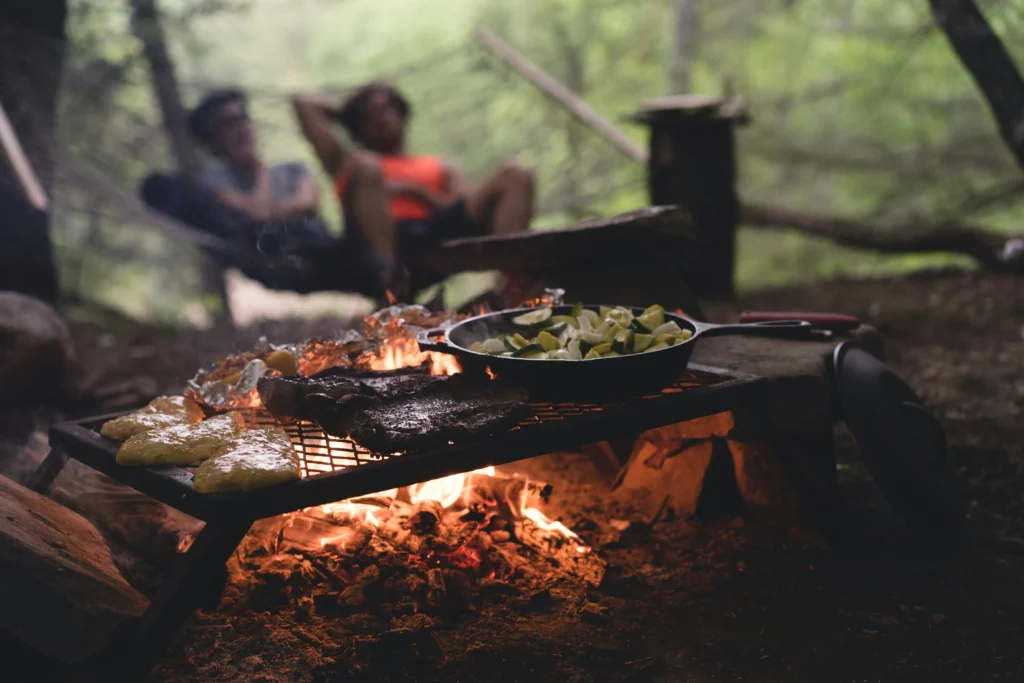
How We Evaluated These Grills
When comparing portable fire grills, we focused on several key factors that matter most to campers:
- Durability: How well does the grill withstand repeated exposure to high heat?
- Portability: Weight, packed size, and ease of transport
- Cooking Performance: Stability, heat management, and versatility
- Value: Price relative to build quality and expected lifespan
- User Experience: Real-world feedback from campers, hikers, and outdoor cooking enthusiasts
Let’s dive into the details of each campfire grill grate to find which one best fits your outdoor cooking style.
1. Coghlan’s Pack Grill: Best Budget Option
What It Is: The Coghlan’s Pack Grill is a lightweight, foldable-leg campfire grill with a simple chrome-plated steel design. It offers just enough space to hold a small pot or pan over an open flame and weighs only 16 oz — making it one of the most compact and budget-friendly outdoor fire grills available.
Why It’s Popular Among Campers: It’s a no-frills, durable platform for cooking basics: boiling water, heating soup, or searing small items. The compact size makes it ideal for solo camper grills or minimalist backpackers who don’t want to fuss with complicated setups.
Pros:
- Very lightweight and affordable
- Simple and reliable for light tasks — easy to use and clean
- Great for emergency kits or quick trips
- Chrome plating reduces the risk of rust but requires careful maintenance (drying and storing in a dry place)
- Legs provide solid elevation above coals
Cons:
- Legs can warp with heavy use or direct flames
- Not suitable for cooking for larger groups
- Small surface area limits what you can cook
Best For: Campers who want a basic, reliable grill platform for solo or lightweight outings — perfect for heating up small meals or morning coffee over the fire when minimalist camping setups are essential.
2. Wolf and Grizzly Grill M1: Best Premium Option
What It Is: The Wolf and Grizzly Grill M1 is a premium, modular campfire grill built from 304 stainless steel, designed to pack down small while offering excellent cooking versatility. The frame folds and the grill surface rolls up, making it one of the most compact full-metal systems on the market for backcountry cooking.
Why It’s Popular Among Campers: Despite weighing only 2.2 lbs, it supports full-size pots and pans and adjusts to three different cooking heights. It’s sleek, durable, and made for serious campers who want performance without bulk on their backpacking cooking gear list.
Pros:
- Rolls and folds into included carry case
- Built from high-grade stainless steel for long-term durability
- Adjustable cooking heights for different heat levels
- Highly compact when stored for minimalist camping setups
- Extremely stable once assembled
Cons:
- Premium price point ($70-90)
- Setup takes a minute to learn
- Grill rods can get sticky without proper oiling
- Smaller cooking surface than some alternatives
Best For: Backpackers and minimalist overlanders who want a high-performance grill that disappears into their pack — perfect for long hikes, bikepacking, or small-group cooking over coals when leave no trace camping principles are important.
Related: For more lightweight outdoor cooking options, check out our article on Mini Stove from Soda Can for the ultimate ultralight solution.
3. Texsport Heavy-Duty Over-Fire Camp Grill: Best for Group Cooking
What It Is: The Texsport Heavy-Duty Over-Fire Grill is a classic folding campfire grill built from welded steel with a black finish. With a 16 x 12-inch cooking surface and stable legs, it’s designed to sit directly over a fire pit or coals for serious camp cooking equipment needs.
Why It’s Popular Among Campers: It offers plenty of space and strength for cooking with cast iron pans, dutch ovens, or directly on the grate. The folding legs make it reasonably packable, and the rugged build is great for group camping meals or vehicle-based trips.
Pros:
- Sturdy welded steel frame handles heavy cookware
- Supports heavy-duty fire grills applications like cast iron
- Folding legs for easier transport in car camping situations
- Excellent for basecamps and long cooking sessions
- Large surface accommodates multiple pots or big meals
Cons:
- Heavier than minimalist options (3.8 lbs)
- Steel can rust without care or proper seasoning
- Bulkier than flat-pack models
- Takes more space in your gear setup
Best For: Campers who want a tough, fire-ready grill for group meals or heavy cookware — ideal for car camping grills, group setups, or extended basecamps when cooking elaborate meals over an open flame.
4. UCO Flatpack Grill: Best Packability
What It Is: The UCO Flatpack Grill is a stainless steel foldable grill and firepit combo that packs down to under an inch thick. Designed for quick setup and easy cleanup, it’s a favorite among campers who want open-flame versatility in a compact form.
Why It’s Popular Among Campers: The UCO Flatpack sets up in under 30 seconds and functions as both a fire pit and cooking surface, making it great for leave no trace camping enthusiasts. The 13 x 10-inch cooking area is enough for small pans or direct grilling, and it packs into a slim nylon sleeve.
Pros:
- Folds completely flat — ultra-packable for lightweight camping grills
- Doubles as a mini fire pit for contained fires
- Rust-resistant grills design with stainless steel construction
- Fast setup and breakdown (under 30 seconds)
- Ideal for overnighters or lightweight car camping
Cons:
- Grill bars are close together — best for flat items
- Not ideal for very heavy cookware
- Firebox depth limits coal load for longer burns
- Higher price point than basic models
Best For: Campers and road trippers looking for a compact, all-in-one fire grill that travels easily and works well at low-impact campsites or beaches where fire-safe grills and contained flames are required.
5. Redcamp Folding Campfire Grill: Best Value
What It Is: The Redcamp Folding Campfire Grill is a stainless steel grate with fold-out legs, offering a solid balance between portability, price, and cooking space. At 2.5 lbs, it’s lightweight enough for car camping yet strong enough to support pots and pans for versatile campfire meal prep.
Why It’s Popular Among Campers: With a 13 x 9-inch cooking surface, it fits easily over most fire pits and provides a stable platform for boiling, grilling, or heating. The foldable design makes packing easy, and the stainless steel frame resists rust and is simple to clean after grilling over coals.
Pros:
- Lightweight and affordable ($20-30 range)
- Foldable legs for flat packing in your camping kitchen essentials
- Easy to set up and clean
- Supports moderate cookware loads
- Great value for casual campers
Cons:
- Not suited for very heavy cookware
- Bars may bend slightly under direct flame
- Lower clearance than some models
- Less durable than premium options
Best For: Weekend warriors and car campers who want a simple, functional fire grill that folds flat and gets the job done without breaking the bank — perfect for affordable campfire grills that still offer good performance.
6. Adventure Seeka Heavy-Duty Campfire Grill: Best Mesh Surface
What It Is: The Adventure Seeka Campfire Grill is a hinged, foldable fire grate made from iron mesh and high-strength steel, offering a rugged and roomy cooking surface for campfire grilling. It’s built to handle larger meals and heavier cookware while folding flat for storage.
Why It’s Popular Among Campers: The 16 x 10-inch grill top provides enough space for steaks, vegetables, or a full skillet. The mesh campfire grill pattern allows even flame exposure and prevents small items from falling through. Its folding legs and built-in handle make it a practical solution for group camping meals.
Pros:
- Heavy-duty mesh surface for direct grilling of smaller items
- Folds flat with locking hinge and carry handle
- Stable on uneven ground for fire pit grilling
- Works great with both pots and direct flame cooking
- Excellent heat distribution for even cooking
Cons:
- Heavier (3.6 lbs) than minimalist options
- Mesh can be harder to clean after greasy meals
- Paint coating may discolor or wear over time with high heat
- Bulkier than some ultralight alternatives
Best For: Campers looking for a robust, fire-ready grill that handles real meals and folds neatly for transport — ideal for family camping trips, car camping, or RV setups where cooking is a centerpiece of the outdoor experience.
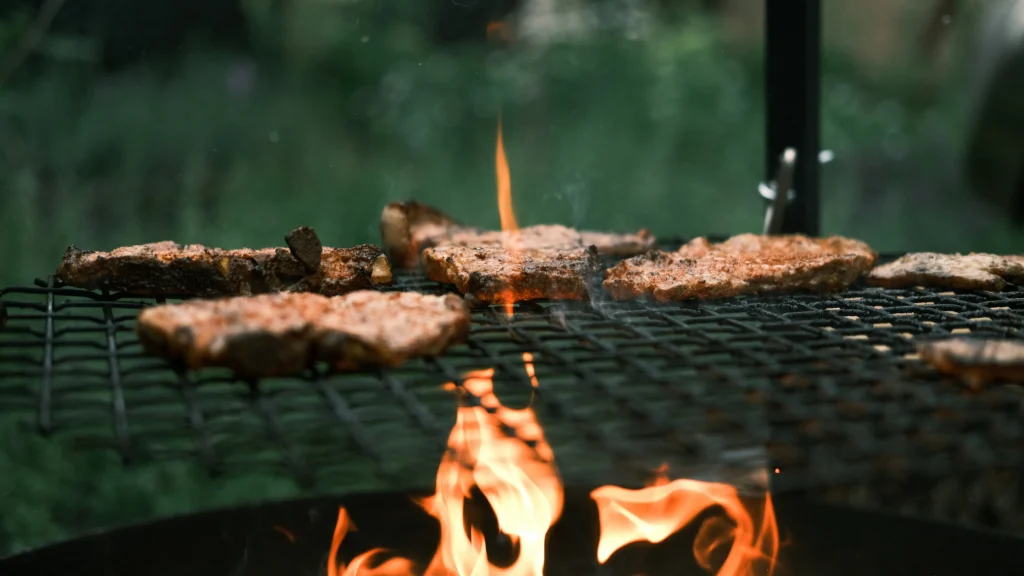
How to Choose the Right Portable Campfire Grill
When selecting the best portable campfire grill for your needs, consider these key factors:
1. Type of Camping
- Backpacking: Prioritize weight and packability (under 2.5 lbs)
- Car Camping: Focus on cooking surface area and stability
- Group Trips: Look for larger grills with higher weight capacity
2. Material Matters
- Stainless Steel: Rust-resistant, easy to clean, but can be pricier
- Chrome-Plated: Affordable, reasonably durable with proper care
- Welded Steel: Heavy-duty but requires maintenance to prevent rust
3. Cooking Style
- Direct Grilling: Mesh surfaces work better for small food items
- Pot/Pan Support: Bar designs offer better stability for cookware
- Versatility: Adjustable height models give better flame control
Related: Combine your campfire grill with the right firestarter! Check out our guide to 7 Best Firestarters for Camping: Complete Guide for All Weather Conditions (2025)
Safety Tips for Using Campfire Grills
When using portable fire grills in the wilderness, follow these safety practices:
- Check Local Regulations: Many areas have seasonal fire restrictions
- Proper Placement: Set up on level ground, away from flammable materials
- Heat Management: Let coals develop rather than cooking over active flames
- Use Protection: Heat-resistant gloves prevent burns when adjusting hot grills
- Complete Extinguishing: Always fully extinguish your fire before leaving
Cleaning and Maintaining Your Campfire Grill
To extend the life of your over-fire cooking grill:
- After Each Use: Brush off debris while still warm (not hot)
- Deep Clean: Occasionally scrub with steel wool and mild soap
- Rust Prevention: Dry thoroughly and apply a light coat of cooking oil
- Storage: Keep in a dry place, preferably in a protective case or bag
- Pre-Season: For non-stainless models, season like cast iron before first use
Conclusion
A great campfire grill brings freedom to your outdoor cooking — no propane tanks, no delicate burners, just fire and food. Whether you’re after a minimalist grate for solo trips or a heavy-duty platform for family-style grilling, there’s a portable campfire grill here to match your needs.
- For ultralight and compact setups, the Wolf and Grizzly M1 or UCO Flatpack are excellent choices.
- If you’re cooking for a group or using cast iron, the Texsport Heavy-Duty and Adventure Seeka Grill offer size and stability.
- On a budget? The Coghlan’s Pack Grill and Redcamp Folding Grill get the job done without taking up much space or cash.
Pick the one that suits your fire style — and enjoy your next trail meal with a proper sear. The best campfire cooking grates transform any outdoor adventure into a culinary experience worth remembering.
FAQ: Portable Campfire Grills
1. Can I use a portable campfire grill with any firepit?
Yes — most portable campfire grills are designed to work with open fires, coals, or basic fire rings. Just make sure the surface is level and stable, and avoid stacking over large, open flames unless the grill is rated for it. For public campsites, check if the fire pit regulations allow portable grills.
2. What cookware works best on campfire grills?
Cast iron, stainless steel, and hard-anodized aluminum are ideal for open-flame cooking. Avoid thin-bottom pans or anything with plastic handles, as they may warp or melt over high heat. When planning your camp cooking equipment, match your cookware to your grill capacity.
3. Are mesh grills better than bar grills?
Mesh grills offer better support for small items (like veggies or skewers) and more even flame exposure, while bar-style grates are easier to clean and better for heavy pots or skillets. Choose based on what you plan to cook most frequently on your outdoor fire grill.
4. How do I clean a portable campfire grill?
For effective campfire grill cleaning, let it cool, then scrub with a stiff brush or steel wool. If needed, soak in warm soapy water back at home. To prevent rust, dry thoroughly and store in a dry place or season with oil, especially for steel models. Rust prevention for grills is critical for extending their lifespan.
5. Are these grills safe for Leave No Trace areas?
Yes — grills like the UCO Flatpack that double as fire pits are ideal for low-impact camping gear usage. Be sure to check local fire regulations and use a grill with a fire pan or foil barrier when required. Safe outdoor cooking practices should always be followed to protect natural areas.
6. What’s the best portable campfire grill for backpacking?
For backpacking cooking gear, weight and packability are crucial. The Wolf and Grizzly M1 and Coghlan’s Pack Grill are among the best foldable campfire grills for backpacking in 2025, offering excellent strength-to-weight ratios and compact packed sizes for lightweight camping grills.
7. How long do portable campfire grills typically last?
The lifespan of portable campfire grills depends on frequency of use and maintenance. With moderate regular use and proper care, high-quality stainless steel grills like the Wolf and Grizzly or UCO models can last 5 years or more. More affordable chrome-plated or painted steel models typically last 2–3 seasons but may wear out faster with heavy use, exposure to moisture, or lack of proper maintenance.
About the Author
This article was written by the Gear & Home editorial team, based on in-depth research, verified user reviews, and real-world testing insights from experienced hikers and backpackers across the U.S.
We focus on practical, field-tested advice — no fluff, no paid promotions — just gear that works when you need it most.

